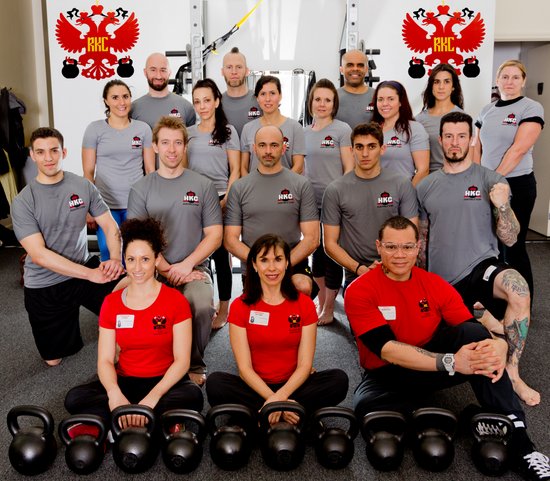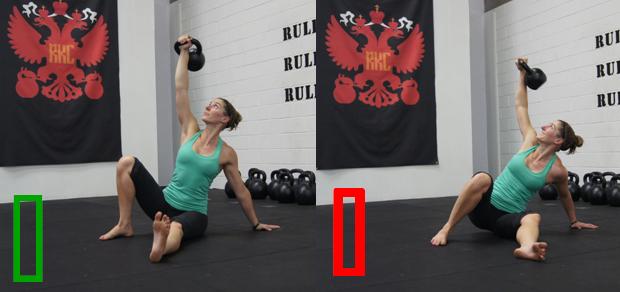I’ve had the honor and pleasure to attend pretty much every certification that Dragon Door has offered for over a decade and I’ve always been impressed with the extremely high quality, professionalism, and thoroughness of each and every one of these events. The quality of the instruction and the enthusiasm of the attendees are unparalleled. So when I heard a recent attendee at an HKC certification make the comment “Why are you being so picky? It’s only the HKC?” I had to respond; but only after I was able to excuse myself, get a drink of water and splash some cold water on my face, and come back and address the question with a level head and something approaching my normal blood pressure…
Introduction
The HKC is comprised of a full day of instruction on three tremendously powerful, important and effective techniques:
- Kettlebell Goblet Squat
- Kettlebell Swing
- Turkish Get Up
A whole day to cover just three techniques?!?! Yes–and even with a whole day to cover them, and a handful of variations, you are still only scratching the surface on how to use, apply, and perfect them. These three techniques will make a huge difference in you and your client’s strength, mobility, athletic ability and longevity. While at first glance they seem to be simple to execute and master you will quickly realize that to truly understand them will take thousands of repetitions and hours and hours of work. At the end of the day you will not only be able to safely and effectively know how to execute these three key techniques, but more importantly you will be able to spot good and bad technique, sequencing errors, and weak links in these core movements.
The Heart of the RKC
 The HKC is the heart of the RKC. It is the strength, conditioning, and mobility foundation that it creates that will allow you to move onto more technical and challenging techniques. Without the understanding of the Swing, Goblet Squat and the Turkish Get UP being successful at the RKC would be impossible. The bedrock that the Snatch, Clean, and Military Press are built upon is the HKC–and they are also the foundation that the RKC II is established upon as well.
The HKC is the heart of the RKC. It is the strength, conditioning, and mobility foundation that it creates that will allow you to move onto more technical and challenging techniques. Without the understanding of the Swing, Goblet Squat and the Turkish Get UP being successful at the RKC would be impossible. The bedrock that the Snatch, Clean, and Military Press are built upon is the HKC–and they are also the foundation that the RKC II is established upon as well.
I have heard the HKC referred to as “RKC-light” or the “mini-RKC” and this is far from the truth. The HKC introduces three essential movements that set the foundation for more advanced ballistics and grinds as well as preparing the athlete to understand how to generate, absorb, and redirect force; key and game changing principles that are essential to high-level performance. The HKC is anything but a “light” version of the RKC–it establishes the awareness of a high quality movement baseline that will follow the athlete from the gym to the field, court, or streets.
Dan John, one of the most sought after and influential strength and conditioning coaches of our era, changed the paradigm for the composition of a complete training program from the time honored “push, pull, and squat” to something much, much more. According to Mr. John an athlete needs to train in the following six areas:
- Push
- Pull
- Squat
- Hinge
- Carry
- Groundwork
When assessing where athletes come short in their training programs, in other words, trying to figure out where they have gaps in their training, you need to look at what they are doing and what they are avoiding. Consistently you will find that most athletes are able to rattle off their Bench Press and Squat numbers but start to mumble when you ask about the rest of their training program. They are invariably short in their Pull, Hinge, Carry, Groundwork, and (quality) Squat movements.
So what does this have to do with the HKC? Everything! If you were to augment the athletes (or your clients) training program to include more quality work in Squatting (Goblet Squat and variations), Hinging (Kettlebell Swings and variations), and Groundwork (Turkish Get Up and variations) you would make a huge and lifelong difference in how they move, perform, and recover. Filling in those gaps would make that much of a difference in the short term as well as having a huge impact on how the move and feel in the coming years. NOTE: I didn’t address the weakness in the Pull movement but that can be easily filled by Pull Ups (think Convict Conditioning) and by Farmer Walks (do a search on YouTube; there are lots of good examples).
Who Should Attend the HKC?
If you are truly interested in improving how you move, feel and perform as an athlete you need to attend the HKC. Even if you have no intention in ever teaching someone else how to use a kettlebell, but odds are you will share this newfound knowledge, you should attend. If you are interested in making a huge dent in your weaknesses, be they strength, mobility, or conditioning, then you need to make the investment in yourself and attend.
If you are a coach or trainer that is looking for a way to “round out” your athletes or clients then the HKC is the answer! Most athletes will hide between the movements that they are comfortable with and have no interest in learning new movement and loading patterns unless you can demonstrate and explain the benefits behind doing Goblet Squats, Kettlebell Swings, and Turkish Get Ups. Attend the HKC and you will be armed with this knowledge and much, much more.
If you are in the Military, Law Enforcement, or Fire/EMS service then you are desperately in need of a fast, efficient, and powerful training program that meet the physical demands of your profession. The foundation created by Goblet Squats, Kettlebell Swings, and Turkish Get Ups will go a long way in keeping your body in peak physical condition to be able to perform your job at a high level and return home, safe and sound, at the end of your tour, shift, or rotation. Because of the time commitment that all of these professions require you need to have a training program that will allow you to train efficiently as well as have carryover into your day-to-day tasks–you would be hard pressed to do better than the information that is presented in the HKC.
If you are a “Coach Potato” or “Weekend Warrior” then you can benefit more than you can imagine. This minimalist approach to training can augment, compliment, or out and out replace your exiting training program; and if you’re not doing any strength and conditioning training on a regular basis then this is a great place to start. With these three powerful techniques you can lose fat, gain muscle, move better, feel better and add quality years to your life – and have fun doing it!
Conclusion
If you are interested in improving how you move, feel, and perform then I strongly suggest that you look at the HKC as the answer to your strength and conditioning questions. The training that you will receive at the HKC is an investment in your health that will pay dividends for the rest of your life. It will be an experience that will change your concept of what effective training is and set a foundation for additional skills that will make you stronger, more mobile, and more effective in your sport of choice; even of your sport of choice is “life”.
Still not sure if the HKC is for you? Then I challenge you to get on the Dragon Door website and reach out to an HKC in your area, or anywhere, and get their feedback on the training they received and how it has impacted their lives. I think you will be surprised on how excited they are about the experience and how much that one day has influenced their training and their lives.
NOTE: If we ever get the chance to meet face to face, and I hope we do, please don’t ask me who said “It’s only the HKC!?!?” I have been sworn to secrecy and I can’t tell you who it was. That doesn’t mean I can’t send you a link to a website through an anonymous email account though… just kidding! My lips are sealed!
***
About Michael A. Krivka, Sr. – Senior RKC: Michael A. Krivka, Sr. is a Washington, DC native who has been involved in Kettlebell training for over a decade and is currently an RKC Team Leader and member of the RKC Board of Advisors and the RKC Leadership Team under Dragon Door (where he has been listed as one of the top reviewed RKC’s in the world for the last five years). He is also the author of a bestselling eBook entitled “Code Name: Indestructible” and is in the process of finishing up several other eBooks on Kettlebells, body weight, and the integration of other tools into an effective strength and conditioning program. Mike has traveled extensively throughout the United States teaching Russian Kettlebells to military (USMC, USN, USA and USAF) and law enforcement personnel (FBI, DEA, USSS and CIA)… read more here.

